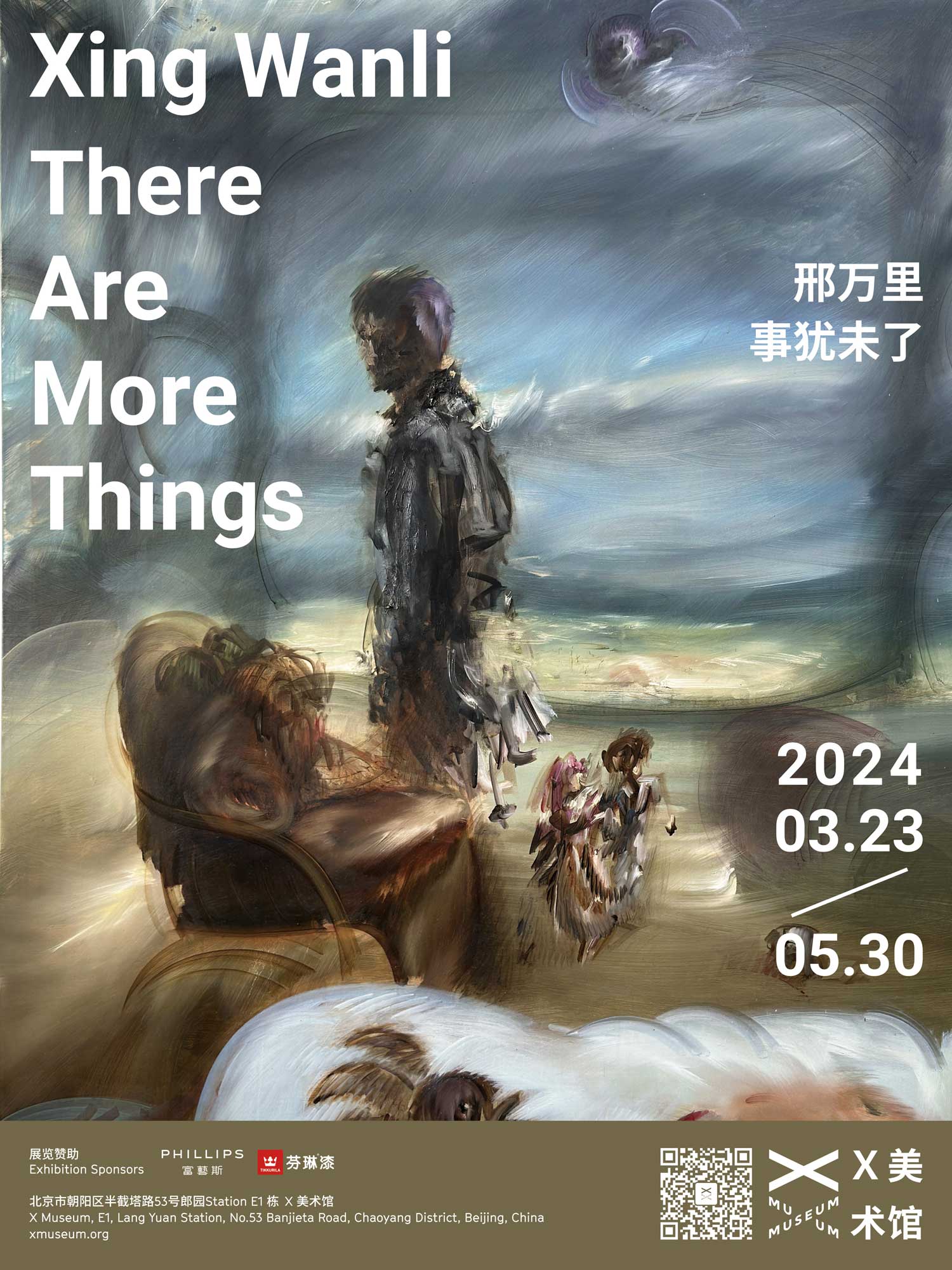展期 Period:
2024.3.23—2024.5.30
艺术家 Artist:
地点 Venue:
新闻稿 Press Release:
2024年3月23日至5月30日,X美术馆将于展厅一至展厅四呈现中国艺术家邢万里个展“事犹未了”。此次展览标题来源于阿根廷作家博尔赫斯《沙之书》中的短篇小说,小说碎片化的讲述方式和戛然而止的结尾让人意犹未尽。而“事犹未了”这个词语本身对于事件存在多种可能性的暗示也为展览带来了开放的想象空间。
本次展览展出了艺术家近年来创作的40余幅作品,这些作品来源于艺术家从多部文学作品、影视作品以及游戏中吸收得到的灵感——村上春树的《世界尽头与冷酷仙境》、《刺杀骑士团长》,约瑟夫·康拉德的《黑暗的心》,托马斯·品钦的《万有引力之虹》等。本次展览的部分新作以小说《1Q84》为线索,艺术家提取了书中的种种主题、情感及意象,如天上的两个月亮,高速公路上的汽车,小小人等并结合自己的现实生活,使得虚拟与现实相融,以此来探索人们生活经验中的共同性和独特性是怎样产生连接的。
艺术家以文学作品中的文本作为据点,融合图像和记忆进行视觉呈现。大面积色块铺成的背景上,交织着一个个暧昧模糊的人物和物体。随机出现的元素和符号使画面变得丰富甚至嘈杂,这样的随机性让作品处于一种不稳定的状态,但也给观者带来发散的体验,如同在“小径分岔的花园”,可以自由选择通往回忆的路径。
亨利·柏格森在《材料与记忆》中写道“作画并非去记住,毫无疑问,回忆一旦变成了实际的回忆,就往往会存活在纯粹而简单的形象里,而不再与过去相关……”做为一个纯粹的形象而存在的记忆就像是一个过去的幻影,我们并不能完全地去描述它。这也使得艺术家在绘画中,需要借助某些新的形象去替代那些过往的形象以再现记忆。图像对文本的再现,记忆对图像的改造,几番构建后,置身于作品前的我们看到的结果既有想象的虚构,也有感觉的真实。邢万里通过对“文本”,“图像”与“记忆”三者关系之间的探索,给作品带来多样的画面,也给观众带来多维度的思考空间。当我们在描述记忆时,有多少是对真实事件的重述,又有多少是对逝去片段的填补与想象?正是记忆的这种混沌性给了艺术家创作的空间,试探的笔触在陌生的路径中探索着未知。正如《1Q84》中描述的同时存在的两个世界——原本存在于不同时空中的文字和图像,经过记忆的调解,交织成为一个个私人的乐园。
From March to May 2024, X Museum will present Chinese artist Xing Wanli’s solo exhibition, ‘There Are More Things’ in Galleries 1 to 4. The exhibition borrows its title from The Book of Sand by Argentinian writer Jorge Louis Borges, whose mysterious styles of narrating and abrupt ending provide an open space for interpretation. The term ‘There Are More Things’ itself also suggests multiple possibilities may exist even in a linear event, which also contributes to the complexity of the exhibition.
The exhibition presents more than 40 works created by the artist in recent years, which are inspired by literature, movies and games, such as Haruki Murakami's The End of the World and Cold Wonderland and The Assassination of a Knight Commander, Joseph Conrad's Heart of Darkness, and Thomas Pynchon's The Rainbow of Gravity, etc. Some of the new works in the exhibition departed from the clues found in the novel 1Q84. The artist extracts various sceneries and imagery from the book, such as the two moons in the sky, the car on the highway, and the little man ...... and further combines these with his real-life experience, allowing reality come to exist with fiction, and exploring how commonalities connect and contest with specialties.
Using texts from literature as anchors, the artist blends images and memories for visual presentation. Color blocks forming the backdrop are intertwined with ambivalent figures and objects. Random elements and symbols make the picture rich and even more noisy. Such randomness puts the work in an unstable state, as if in‘the garden with forking paths’, where one is free to choose the path leading to memories.
Henri Bergson wrote in Matter and Memory,‘to paint is not to remember, and there is no doubt that memories, once they have become actual memories, tend to live in pure and simple images and are no longer associated with the past……’Memories that exist as pure images are phantoms of the past, which cannot be fully described. This makes it necessary for the artist to replace the image of the past with a new image to reproduce the memory. The image reproduces the text, the memory transforms the image, and again, at the end, what we see is a combination of fiction and reality, a mixture of imagination and feeling. By exploring ‘Text’, ‘Image’and‘Memory’,Xing brings a variety of images to his works, as well as a multi-dimensional space to contemplate. When we describe our memories, how much of it is related to the actual events, and how much is a fabrication of lost fragments? It is precisely this chaotic nature of memory that inspires the artist to explore, with tentative strokes traversing the unfamiliar paths. As described in 1Q84, the two worlds that exist simultaneously - words and images that originally existed in different times and spaces - are interwoven into a private paradise through the mediation of memory.

